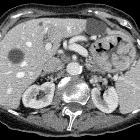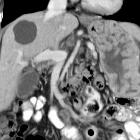Morbus Ménétrier









Ménétrier disease, also known as giant hypertrophic gastritis or hypoproteinemic hypertrophic gastropathy, is a form of rare idiopathic hypertrophic gastropathy.
Epidemiology
Rare disease with incidence <1 per 200,000. Bimodal in distribution, children often <10 years; adult forms 30-60 years, peak 55 years. There is a male preponderance in both the juvenile and adult forms .
Clinical presentation
Achlorhydria, hypoproteinemia and edema comprise the classic triad. It is thought to be caused by protein-losing enteropathy. Acid production may be compromised. Hypoproteinemia may lead to ascites and pleural effusions. It is also characterized by excessive mucus production .
Pathology
The exact etiology is not well known. The juvenile form has been linked to cytomegaloviral infection and usually resolves spontaneously. The adult form tends to progress with time and TGF-A activation of the EGFR receptor has been implicated.
The characteristic of the disease is gastric mucosal hypertrophy, which may cause the rugae to resemble convolutions of the brain . Rugal thickening is predominantly caused by the expansion of the epithelial cell compartment of the gastric mucosa
Location
It most commonly affects the gastric fundal region, but any part of the stomach may be involved.
Radiographic features
Fluoroscopy
Upper GI fluoroscopy findings include :
- markedly enlarged and tortuous folds in the fundus and body, especially along the greater curvature, with sparing of the antrum
- barium is diluted due to mucus hypersecretion, leading to impaired mucosal coating
CT
On contrast-enhanced CT images, the thickened rugae appear as areas of thickened mucosa that project into the gastric lumen to a degree that may resemble convolutions of brain . Gastric wall thickness is normal between folds .
Treatment and prognosis
- high-protein diet to correct hypoproteinemia
- proton pump inhibitors (PPI) to treat attendant gastritis
- EGFR monoclonal antibody (cetuximab)
- gastrectomy
History and etymology
It is named after Pierre Ménétrier (1859–1935), a French pathologist who described certain pathologic gastric changes associated with the condition in 1888 .
Differential diagnosis
Imaging differential considerations for diffuse rugal thickening include
- gastric lymphoma may also occur as part of post-transplant lymphoproliferative disorder affecting the stomach
- forms of gastritis
- infective gastritis
- radiation gastritis
- eosinophilic gastritis
- Zollinger-Ellison syndrome
Siehe auch:
und weiter:

 Assoziationen und Differentialdiagnosen zu Morbus Ménétrier:
Assoziationen und Differentialdiagnosen zu Morbus Ménétrier:


